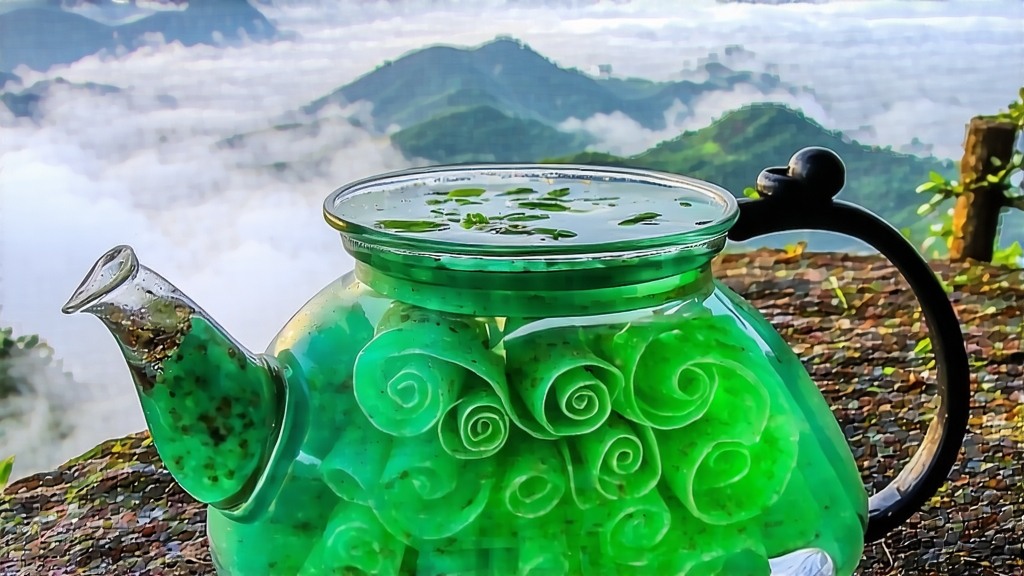
Biluochun, whose name translates literally to “Green Snail Spring,” is one of China’s ten most celebrated teas, yet it remains a quiet mystery outside specialist circles. Grown in the mist-locked hinterland of East China’s Lake Tai, this micro-rolled green tea carries within its tiny spirals the perfume of apricot blossoms, the minerality of sub-tropical terroir, and six centuries of imperial lore. To understand Biluochun is to listen to a spring breeze translated into taste, a lesson in how Chinese gardeners, poets and emperors once agreed upon a single leaf as worthy of tribute.
Historical whispers place the tea’s birth during the late Yuan dynasty, when a monk on Dongting’s Dongshan peninsula noticed that tea bushes growing wild among peach, plum and loquat trees yielded unusually fragrant leaves. Locals began hand-rubbing the leaf into tight spirals so it would keep during the long boat journey to Suzhou’s canalside markets. Fame arrived suddenly in 1699 when the Kangxi Emperor, touring the lower Yangtze, tasted an infusion whose aroma reminded him of the first day of spring. He christened the tea “Biluochun,” replacing its humbler market name “Xia Sha Ren Xiang” (“Scary-fragrant”), and annual tribute quotas were fixed at 18 jin (about 9 kg) of the finest buds. From that moment the tea entered the Qing court’s pharmacopoeia, exchanged as diplomatic gift along the Tea-Horse Road and, in 1915, won gold at the Panama-Pacific Exposition in San Francisco, sealing its international reputation.
Strictly speaking, only leaf picked within a 12-km radius of Dongting’s Dongshan and Xishan villages can claim the state-protected “Original Locale” label. Here the lake acts as a thermal regulator, cooling summer nights and warming winter dawns; morning mist filters UV light, forcing the bush to synthesize more theanine and aromatic volatiles. Two cultivars dominate: the small-leaf “Dongshan Original” that gives classic orchid sweetness, and the heartier “Xishan Small-Leaf” prized for its marine umami. Beyond the lake, similar crafting techniques are applied to create “Suzhou-style” Biluochun grown in Sichuan or Guizhou, yet connoisseurs insist the lake’s micro-aquatic climate is irreproducible.
Crafting Biluochun is a race against dawn. Picking starts when air temperature hovers around 12 °C, usually the Grain Rain window (early April), because cooler weather keeps the bud’s cellulose tender. Only the “single spear” standard—an unopened bud with an attached half-leaf—is acceptable; 70,000 such tips yield one finished kilogram. Once bamboo baskets reach the village workshop, the leaves are spread 2 cm thick on hemp cloth to wither for precisely 90 minutes, long enough to shed grassy bite yet short enough to preserve jade color.
The most iconic step is hand-firing in a 180 °C wok, a ballet the locals call “three sweeps, three trembles.” With bare palms the tea master tosses 250 g of leaves high against the wok wall, then gathers them back in a single circular motion; the impact against hot iron softens cell walls, priming them for the signature roll. Temperature is modulated every 30 seconds by adding or removing charcoal embers, judged solely by the roast-nut aroma rising from the wok lip. After six minutes the leaves are transferred to a bamboo tray where elderly craftswomen roll them against the weave, curling each bud into a tiny snail shell while it is still above 60 °C. The friction polishes the surface, locking in white downy hairs that will later shimmer like frost in the cup. A final gentle bake at 80 °C reduces moisture to 5 %, low enough for year-round cellaring yet high enough to keep the leaf pliable.
To brew Biluochun like a Suzhou tea master, begin with soft water whose mineral content sits below 80 ppm; the lake itself is naturally filtered through limestone, so locals simply draw from their wells. Pre-heat a tall glass to 75 °C—any hotter will “cook” the down and release bitter tannins. Use a 1:50 weight ratio, roughly 3 g for a 150 ml glass. The traditional “three-stage infusion” is as much performance as protocol: first, fill the glass one-third